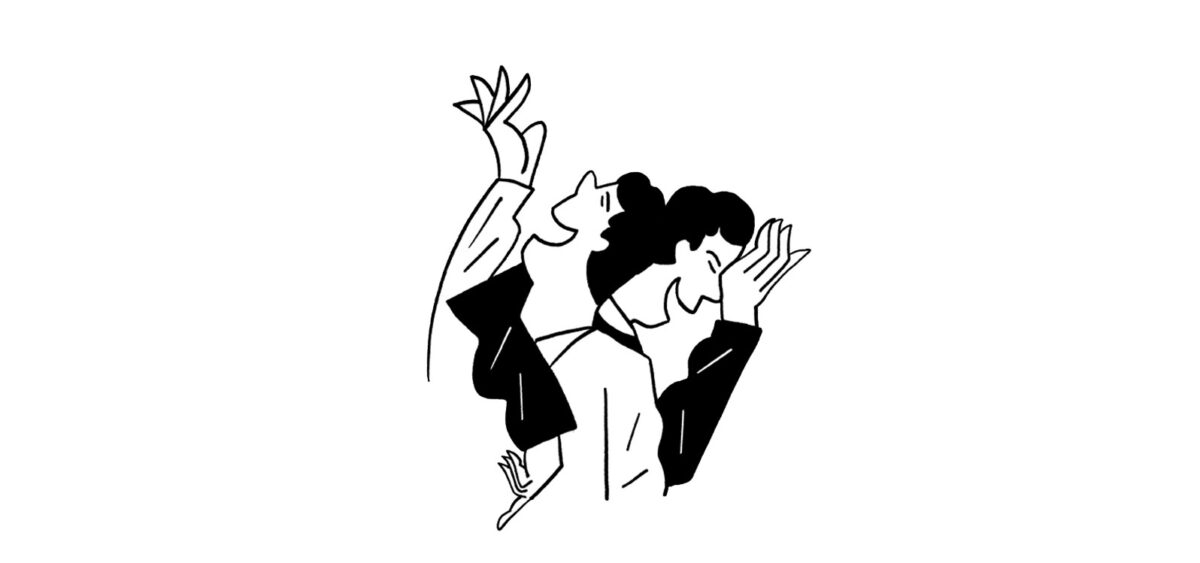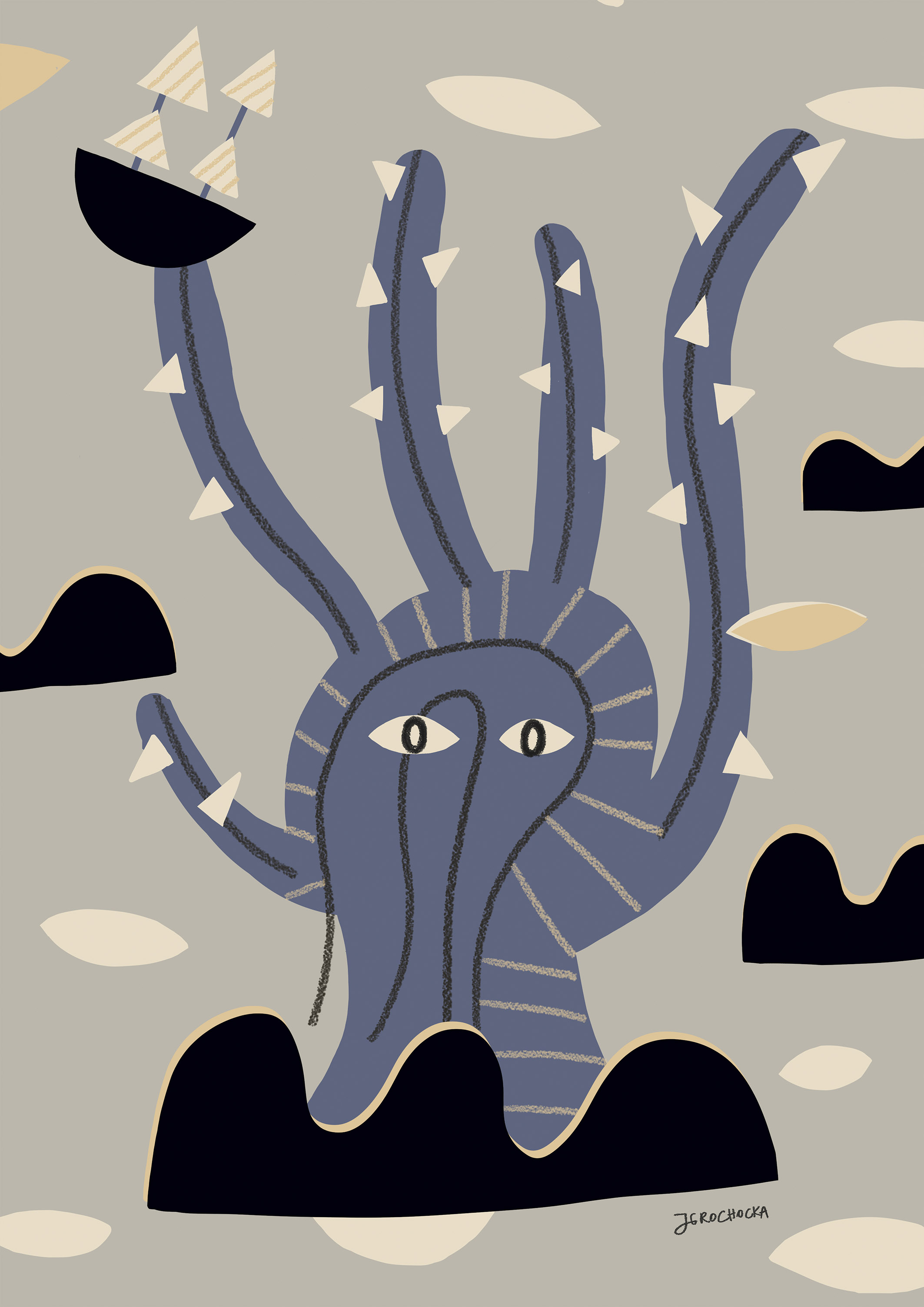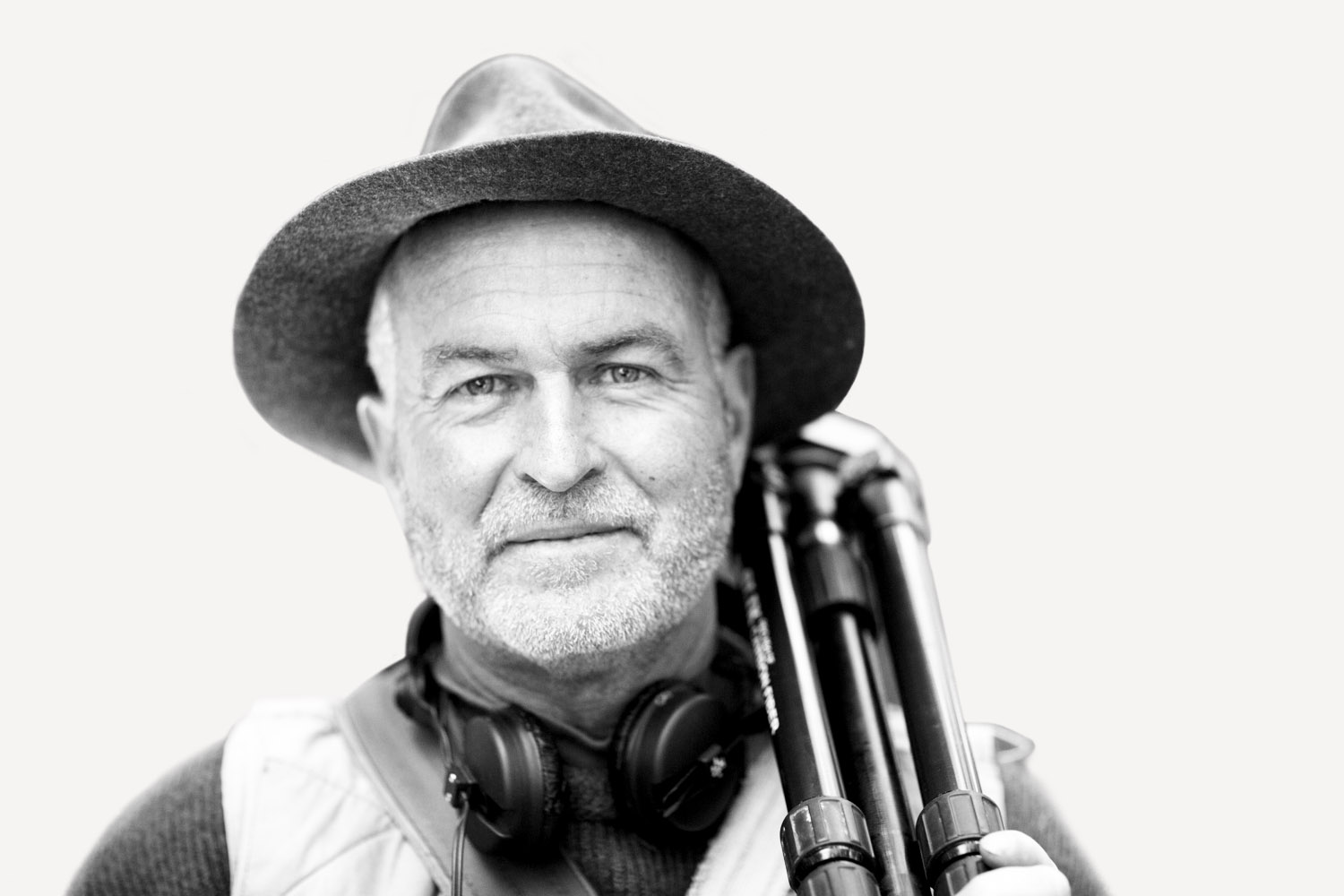
Sebastian Gendry, a ha-ha-highly gifted proponent of a certain ultra-serious method of strengthening the immune system, speaks perfectly seriously with Maria Hawranek.
Maria Hawranek: Supposedly you’re not funny.
Sebastian Gendry: Unfortunately. I can’t amuse an audience.
And even so, you make everybody laugh.
The word ‘laughter’ in English, French or Polish doesn’t really mean anything. When you say you’re exercising, what are you really thinking of? A walk, or a marathon? We have to be more precise. There are five types of laughter in total. Culturally, it’s easiest for us to recognize spontaneous laughter, which appears for example when we react to something funny.
What are the other types of laughter?
The second is stimulated laughter, meaning the effect of a specific action, such as tickling. Stimulating somebody to laugh this way is OK only if the other person can say ‘no’. The third type is induced laughter, of the chemical type. It’s caused by something like breathing in nitrous oxide, and is used only for medical purposes. The fourth is pathological laughter, when somebody can’t hold themselves back.
Like the Joker?
Not entirely. For him it was more an expression of pain. Pathological laughter, which requires pharmaceutical treatment, affects a small percentage of people with brain damage, such as that acquired from a stroke, or Alzheimer’s disease. And finally the fifth category: intentional laughter, voluntary, which I use in my work. You can decide on it consciously. This type of laughter is the simplest way to look into your own internal medicine chest and get your positive chemistry moving. In the 1970s, it was described by the American psychologist Annette Goodheart as a way of treating the mind, and it became known thanks to the practices of Indian laughter yoga, which during the past two decades inspired thousands of laughter clubs around the world.
Isn’t this intentional laughter somehow forced? Artificial?
Words are extremely important: forcing yourself is a bad idea – you allow this laughter. It’s not about pretending; you really want to laugh, you choose this consciously. The world of laughter therapy is completely counter-cultural: everybody agrees that laughter puts you in a good mood, that it’s a pleasant activity, and simultaneously the first one we give up when life just begins to get complicated. Isn’t it strange that you have to be convinced to laugh? I use it as a tool for work on intention, on your approach. From this point of view you can choose laughter. It’s precisely when you give in to various emotions hidden in the darkest corners of your soul that you most need balance and activity.
Meaning I’m sad, so I laugh?
Of course there’s a time for sadness and a time for crying. Laughter also brings you to tears, but they’ll be cleansing. Our minds don’t operate in a vacuum; we don’t suddenly immerse ourselves in clouds of sadness or joy. We live in the material world, each of us has a body, our thoughts are the result of electrical and chemical connections between our neurons. Everything is connected. How I behave affects how I feel, and this in turn acts on the way I think. I’m not saying people sunk in depression suffer because it’s their own fault, but that it’s easy to create around yourself an aura of anger, sadness and suffering. Do you know what metaprogramming is about?
More or less.
A computer has software running, but over it there’s also the whole system – the metaprogram. In our case, this metaprogram is called a sense of locating control. In the 1960s, Julian Rotter noticed that from the time we’re born till the time we die, people learn to believe either that we direct our own lives, or that what we encounter is determined by independent factors such as fate, luck, God or destiny. And so the question is: Am I running my life, or is somebody else responsible for it? Does life happen to me, or do I fully live it? If I have cancer, is it a blessing or a curse? If I break my leg, is that good or bad? Each of us answers similar questions. Meanwhile, I perceive that we live in a culture of victims: it’s not me, they did this to me. Most people operate in the paradigm ‘life happens to me’. I try to push the other approach, which means that each of us has a choice – you can choose laughter, express yourself the best possible way. And the whole thing hinges on how, when you laugh, everything changes.
You live in California, and the US is recognized as the homeland of the superficial smile, pasted on your face. It doesn’t work too well, does it?
No, on the contrary – it brings you down! Let’s do a simple exercise.
OK.
We’re not going to talk. Show me your best smile, use your whole face, your eyes. In your mind, repeat to yourself that we have no connection and you don’t care about me at all. [10 seconds passes] OK, now show me that same smile again, but looking at me, repeat in your thoughts: We have something in common, I don’t know what yet, but I’d really like to know. What’s the difference?
I really feel the second one.
Exactly! In some workplaces you have to smile even on the tough days. That leads to muscle fatigue and a feeling of disintegration, because in the depths of your soul you know you’re unhappy, and pretending makes you feel even worse. So it’s not really about what you’re doing, but about your approach; your intentions, as in our exercise. Because, after all, we can always smile at somebody. But if you’ve gotten stuck, you’re facing huge challenges, you might not be so eager to. And on the other hand – why not? Why do you want to be so attached to your problems? People often become convinced that they’re victims, and explain to themselves and others why they can’t change anything. Then they just repeat: “Do you know who I am? What I’ve gone through?”
Why is it worth building this laughter in yourself at all?
The benefits of laughter are numerous and scientifically proven. As we know, the body is a mass of cells, and each of them needs oxygen. Laughter brings more oxygen into the bottom of the lungs, and absorption is better there than at the top. Animals who breathe fast, like birds or mice, die sooner. But those who breathe more slowly, like elephants and turtles, live for a long time. Laughter works the muscles of your face, chest and belly, and your skeletal muscles; it gets your diaphragm moving and slows your heart rate, which lowers your blood pressure and improves your circulation and metabolism. We quickly feel both more relaxed, and at the same time charged with energy. Laughter also triggers the secretion of serotonin, endorphins and dopamine, which are responsible for things including our feeling of happiness, tolerance, empathy. Our intellectual capabilities improve, our thoughts are more coherent, we tolerate pain better. Laughter causes brain waves similar to those that appear during deep meditation. And it makes us more resilient: an active diaphragm gets the lymph flowing. The lymphatic system, as opposed to the circulatory system, doesn’t have a pump like the heart; its movement comes from our movement, mainly breathing. And when the circulation of the lymph is better, the whole immune system is strengthened. If you breathe shallowly all the time, disease is just a question of time. Same if you don’t move. Sitting kills. If you sit for more than six hours a day, it’s worse for you than smoking. That’s why laughter is the perfect tool, a stationary jogging, ideal for everyone regardless of age and fitness level. It’s a blessing for those who can’t move around, e.g. because they’re in hospitals or care homes.
Supposedly you haven’t fallen ill for 23 years now.
That’s right. Of course, if I don’t get enough sleep or don’t eat regularly, even just because of travel, I get the precursors of infection, such as a slight headache, which goes away after two days of laughter treatment. You can’t say laughter is the best medicine, because this can’t be proven. That’s the first thing. And second, I don’t say – and I hope nobody does – that laughter is alternative medicine. No! It’s more a form of complementary medicine, a way to take care of your well-being.
So how does it actually work?
Imagine you’re eating a lemon. The more your imagination comes to life, the more you’ll wince and cringe. The body doesn’t know you don’t have a lemon in your mouth. It’s the same with laughter – your mind will know the difference between stimulated and spontaneous laughter, but not your body. All it can do is feel. That’s why the benefits of laughter depend on its duration, frequency and intensity, but not on what causes it.
All of this is well-documented scientifically?
The science of laughter is young and weak, and simultaneously old and strong. Decades of research are linked together by only one thing: the word ‘laughter’, which as we now know can be defined in various ways. On the one hand, these experiments seem weak, because they’re independent, not replicated. And on the other hand, there is a great deal of evidence that laughter undoubtedly has a positive effect on our health and is the perfect example of complementary medicine, which enriches all forms of treatment. Cancer, Parkinson’s disease, depression or any other ailment: take your medicine and laugh, and you’ll note a significant change. Some people from medical circles already perceive this – sometimes even whole institutions, such as my French colleague who signed a contract for laughter yoga lessons in local clinics. But these are still individual cases; we need another 10-20 years for laughter to become widespread in medicine. For me, the greatest impression is from people suffering from Parkinson’s. They come to a session and they’re shaking all over. After 60 minutes they leave straightened up, without trembling, because their brain has received a hearty dose of dopamine.
Unbelievable. Could you tell us about a particular person who has derived health benefits from laughter?
There are many such examples in every country where you can sign up for laughter yoga. The best known is the story of Merv Neal in Australia. From childhood, he was obsessed with money; he wanted to become a multimillionaire before he turned 45. He achieved it, sold the company and in the end went to a doctor to be tested – for a long time he had been waking up with blood on his pillow, and his body was covered with bruises. After a few hours, they call from the hospital: “Where are you?” “At the office,” Merv says. “Please stay there, we’re sending an ambulance for you.” The guy doesn’t agree to lie down on the stretcher, he follows the ambulance in his car, rejects this whole event. In the hospital, he walks past the wheelchair that’s been prepared for him. After more tests he hears: “You have no right to be alive.” The doctors send him home with a recommendation to do the Four Fs: say goodbye to family and friends, get your finances in order and organize your funeral. He was diagnosed with aplastic anaemia, which leads to a gradual reduction in the number of blood cells.
And?
And he starts to laugh hysterically at the whole thing! I mean, it’s absurd, and we often react exactly this way to absurdity. Merv had toiled his whole life to get what he had, and now it would all be taken away. So he laughs in the doctor’s office, and after getting home, he laughs for so long he faints from exhaustion. Then he calls his friends and asks: “Hey, what are you doing on Sunday? That’s when my funeral is.” And he’s laughing the whole time. On Monday he goes to the doctor and says: “Doctor, I’m still alive, what should I do?” The doctor recommends that Merv just do what helps him. The guy buys a dog, takes him for walks, laughs and encourages others to laugh. For years. The science of laughter is to a large degree based on individual cases; the fact that somebody recovered doesn’t mean the same thing will happen to somebody else, because there are many things that influence us. There are many such stories.
Please name a few more.
Gita Fendelman suffers from Parkinson’s; she conducts laughter yoga lessons. Andréa Crisp, who was widowed before age 30, has fibromyalgia and seasonal depression. And then there’s my great inspiration, Jacqueline Domhoff from Peru. She’s no longer alive, but when she was diagnosed with advanced cancer in both ovaries, she heard that she had just a few months to live. She spent that time laughing in laughter clubs. The growths disappeared, and Jacqueline lived six more years and founded the Hospital of Joy.
In your TED talk, you admitted that you had to go through a second nervous breakdown before you finally tried laughter.
I read about Dr Madan Kataria and laughter yoga for the first time in 1998, and I remember exactly what I thought: “This is some kind of total idiocy, there’s no reason to try it.” It was only after six years – full of pain, sadness and stress – that I became aware that actually I never really laughed, while those people I assumed were idiots, who met every day in the parks of Bombay and laughed together, were getting a range of significant health benefits. As you know, after university I wanted to travel, but I also needed to earn money. My friends and I had an idea for a business, and we managed to get it going. And even though I planned to leave after I had made a million pounds, I got pulled in. At the age of 35, I was professionally burnt out, divorced, I felt like a loser in every area. I got on a plane from Los Angeles to Bombay. The first day after my session with Dr Kataria, I finally got a good night’s sleep. I connected with people at a deeper level than ever before, even though I didn’t even know them!
Let’s imagine that we’re meeting for a laughter session. How do I stop thinking about how it’s strange to laugh like a slack-jawed fool? How do I stop judging myself?
It’s hard to feel not good enough, or to fear the reaction of others, and at the same time engage in an activity that shows the opposite – like laughter. I’ll sketch something out for you. Throughout all our lives, the human mind functions on a horizontal line. It’s kind of like the flight of a dualistic airplane: on one end of the continuum is what I like, and on the other, what I don’t like. Along the way [Sebastian makes x’s on the curve] sometimes I’m sad, and sometimes happy; we plot these experiences on a vertical line. [Now he draws a vertical line that intersects the horizontal one at a right angle.] The human body lives vertically: it can’t think; there’s only the here and now. You feel pain or joy only at a given moment. But you’ll remember it and mark it down on this horizontal line. You asked how to stop thinking that something is strange. This concept functions only in the mind. If you shift from thinking to doing, the problem disappears.
And during the session you do a range of exercises.
Exactly. It’s a kind of semi-hypnotic process, exercise after exercise. Raise your hands and say: “Yes!”
Yes!
Before you manage to think whether this is good or bad, you’re already doing the next exercise and the one after that. Before you realize it, you feel better. Certain interactions in the group last a few seconds; others, 30-40 seconds. Usually 5-10 minutes of physical activity is enough to get the chemicals moving that change how we feel, and as a result, how we think. If you jump up and down for 10 minutes now, then at the end of our conversation you’ll feel different, more relaxed, energized, if for no other reason than the shock of oxygen. After a laughter session the way you perceive me also changes, we won’t be such strangers. The mind is more orientated toward the here and now, you slowly start to function outside time, you stop thinking about how you’re angry, stressed because of something that happened in the past, or worried about what’s about to happen. If you free yourself from the category of time and stop thinking about it, you enter the world of potential and start to repeat to yourself: “I feel good, I’m complete, and the world is safe. What can I do now?”
So laughter is a tool.
Yes, the point is to raise your energy level. Laughter is a declaration of independence: it frees you from fear, stress, unease and other similar feelings. From my point of view, what’s happening in the world isn’t as important as how you experience it. You can’t control what happens to you, but you can choose what you do with it.
How does the concept of laughter yoga differ from your original concept of laughter wellness?
The world of laughter yoga is very diverse. After my experience in India I returned to the States and I read, experienced, went deeper. Laughter yoga sets itself the goal of connecting with the inner child, it uses many playful techniques, including the typical lion laughter. I created the concept of laughter wellness, which is a bit more mainstream, and it’s easier for us to reach professionals – corporations, hospitals, educational institutions, which I work with. Laughter wellness includes laughter in the process of personal development. Laughter as an expression of the best part of who you are. It’s also a very simple trick that helps us in return to see the human in ourselves and in others.
And to be happy?
You can’t rationalize joy, because it’s an experience. And happiness is a concept. I’d even say a very harmful one.
How’s that?
Happiness puts you back in the position of opposition: I’m happy or unhappy. We’ve bled before and we’ll bleed again, that’s just life, but it’s nothing bad. Our goal isn’t happiness, but calmness of spirit, of mind. It’s being the best you can be, here and now. With what you happen to have. And happiness is a concept that orders us to think tomorrow will be better. But tomorrow never comes! It’s already here – now.
This all sounds like old East Asian teaching.
Not at all! It’s a heritage from our ancestors from across the whole world. All of them had this knowledge, that’s how our entire species was designed. Devotees of Taoism or the Buddha only put into words what many people experienced; the ancient Poles must have too. I believe there’s nothing in us that needs to be fixed; nobody is broken. The Dalai Lama believes there’s no situation that would be bad from every point of view. If you accept your pain, it will go away in the end. Thanks to scientific research on the method of dealing with pain, we know that 93-95% of pain is in your head. I’m not saying to write this feeling off, but that we should be aware that it happens mainly in our mind. Pain is like water. When you block its flow, pressure is created, which only makes the situation worse. But if you flow with the pain, the sadness, if you embrace it, it disappears. Everything you push away comes back. Do you see that bell?
A typical Christmas one, you associate it with the song “Jingle Bells”.
What’s its message? Look. If I hold it the right way, it makes a sound, and if I squeeze it in my hand, it stays silent. You and I are exactly this kind of bell. And the pressure that takes away our voice is stress and overthinking. You can’t add laughter or joy to your life. They’re already there. They make themselves known when you just let go of what’s holding them back. In laughing, we don’t add anything new; we only open up a certain artificial blockade that we’ve imposed on ourselves. Then you have a feeling of lightness, you grow within yourself. “I don’t completely understand what happened, but I feel great.” I’ve heard things like that so many times. Recently a man came up to me and said: “I finally feel good. My son had a car accident last week. I don’t know if he’ll survive. But now I can finally breathe, I don’t feel fear.”
How can we practice laughter to experience its positive effects? How often? With someone else? Alone?
Our bodies are programmed to laugh. Laughter is a tool of socialization. It’s easier to do it in a group than alone. Children don’t laugh more because they’re immature and don’t have the same worries as adults, but because they spend a lot of time playing with others. Laughter in company awakens energy. Even one hour a week makes a huge difference in our lives. If you can laugh every day for as little as a minute, that’s great. But remember: it’s not about what you do, but the intention with which you engage, to celebrate life as a source of joy. Tell me, in the end, what do we have to lose?
Parts of this interview have been edited and condensed for clarity and brevity.
Sebastian Gendry:
A promoter of laughter as a therapeutic tool in the US and other countries, he created the method of laughter wellness, founded Laughter Online University and inspired the creation of hundreds of laughter clubs around the world. French by birth, a businessman by education, he has been living and laughing in Los Angeles for many years.










